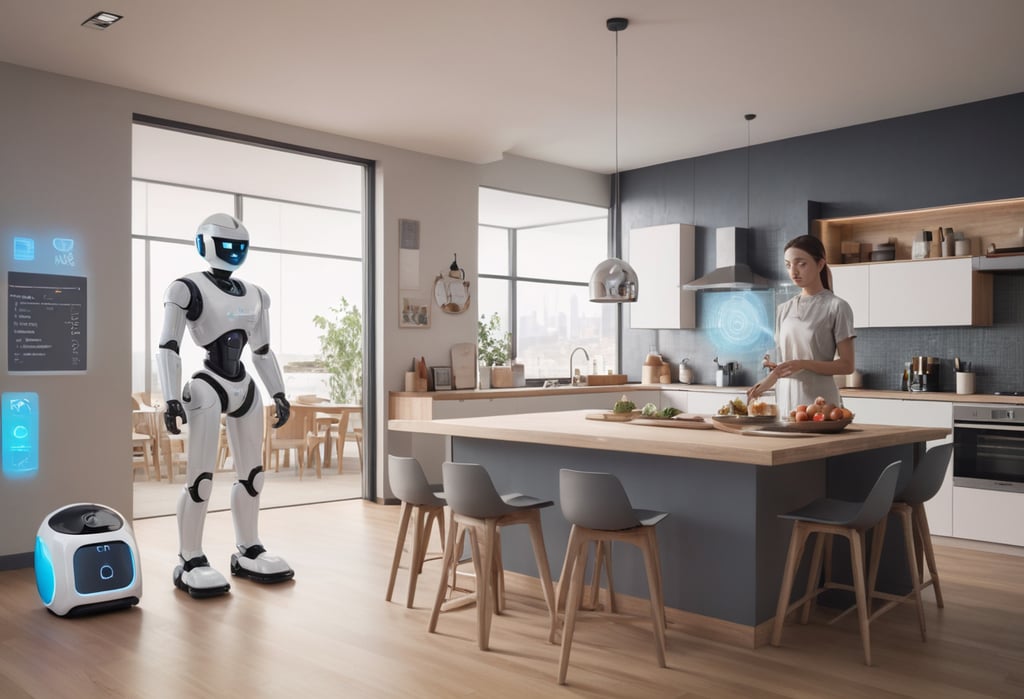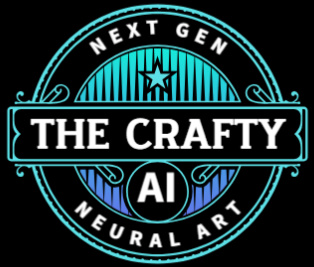The Future of AI: What to Expect in the next 5-10 Years
Discover how AI will transform daily life in 5-10 years with home robots, smart assistants, and autonomous travel, using examples like Amazon Astro. Explore time-saving tools, well-being boosts, 2035 predictions, and ethical challenges ahead.
AI FUTURE


Artificial Intelligence (AI) is poised to redefine convenience in our daily lives, seamlessly integrating into our homes, routines, and interactions. From intelligent personal assistants to robotic helpers, AI is set to introduce tools that anticipate our needs, automate mundane tasks, and enhance our quality of life. This blog explores how AI will transform everyday living over the next 5-10 years, with a focus on robots in the home, emerging tools, and their impact on convenience, supported by real-world examples and forward-looking predictions.
AI-Powered Personal Assistants: Beyond Voice Commands
Today’s virtual assistants, like Amazon’s Alexa or Google Assistant, are just the beginning. Future AI assistants will evolve into proactive, context-aware companions that anticipate needs before we voice them. Using advanced natural language processing (NLP) and predictive analytics, these assistants will analyze patterns in our schedules, preferences, and habits to offer tailored suggestions.
For example, imagine waking up to an assistant that not only reads your calendar but also prepares your coffee, adjusts the thermostat based on your morning routine, and suggests a quick workout tailored to your fitness goals. By 2030, companies like xAI could enhance platforms like Grok to integrate with wearables, home sensors, and even biometric data, creating a holistic assistant that manages your day seamlessly.
Example: Samsung’s Ballie Robot
Samsung’s Ballie, a spherical home robot unveiled at CES 2020, hints at the future. Equipped with AI, cameras, and sensors, Ballie follows users, controls smart home devices, and even acts as a fitness coach. Future iterations could use AI to learn household routines, reminding you to take medication or alerting you to a low fridge inventory.
Future Impact: These assistants will reduce mental load by automating decision-making for routine tasks, such as scheduling or grocery ordering, saving hours each week. They’ll also integrate with augmented reality (AR) interfaces, projecting information like recipes or reminders onto kitchen counters.
Robots in the Home: Your New Helpers
Robotic helpers are set to become commonplace, transforming homes into efficient, self-managing ecosystems. Unlike today’s single-purpose devices like Roomba vacuum cleaners, future home robots will be multi-functional, combining AI with advanced robotics to perform tasks like cleaning, cooking, and caregiving.
Cleaning and Maintenance: Next-generation robots will go beyond vacuuming to handle complex chores. Imagine a robot that dusts, mops, and organizes clutter, using AI to navigate cluttered spaces and learn your home’s layout. Companies like iRobot are developing AI-driven robots that map homes in 3D, avoiding obstacles and optimizing cleaning routes.
Cooking and Meal Prep: AI-powered kitchen robots, like Moley Robotics’ robotic kitchen, can prepare meals by mimicking human chefs. These systems use machine learning to replicate recipes or create custom dishes based on dietary preferences and available ingredients, reducing time spent cooking.
Caregiving and Companionship: For aging populations, AI robots will provide companionship and support. Robots like SoftBank’s Pepper or Toyota’s Human Support Robot use NLP and facial recognition to engage in conversations, monitor health, and assist with mobility, offering independence to seniors and reducing caregiver burdens.
Case Study: Amazon Astro
Amazon’s Astro robot, launched in 2021, is a home assistant that patrols for security, delivers items, and interacts via voice commands. Future versions could integrate advanced AI to perform tasks like folding laundry or watering plants, using computer vision to recognize objects and environments. By 2030, such robots could be in 10% of U.S. households, per industry forecasts.
Future Impact: Home robots will save time and enhance accessibility, particularly for busy families or those with mobility challenges. However, their adoption will depend on affordability, with costs expected to drop as production scales.
Smart Homes: AI as the Central Brain
AI will transform homes into intelligent ecosystems, with devices communicating seamlessly to optimize comfort and efficiency. Smart thermostats like Nest already learn temperature preferences, but future systems will integrate with weather forecasts, energy grids, and personal schedules to minimize costs and environmental impact.
Energy Management: AI will optimize energy use by predicting consumption patterns. For example, Google’s DeepMind has reduced data center energy use by 40% using AI. Similar systems in homes could adjust lighting, heating, and appliance use, saving 20-30% on utility bills.
Security and Safety: AI-powered security systems, like those from Ring, will evolve to use facial recognition, behavioral analysis, and predictive algorithms to detect threats proactively. For instance, a system might alert you to an unrecognized face at your door or detect unusual activity patterns, such as a delivery left unattended.
Inventory and Maintenance: Smart refrigerators and pantries will track inventory, suggest recipes, and auto-order groceries via platforms like Amazon Fresh. AI will also predict appliance maintenance needs, scheduling repairs before breakdowns occur.
Example: LG’s Smart Home Ecosystem
LG’s ThinQ platform integrates AI across appliances, allowing a refrigerator to communicate with a washing machine or oven. By 2030, such systems could use AI to manage entire households, from optimizing energy to coordinating chores, reducing household management time by up to 15 hours weekly.
Future Impact: Smart homes will streamline daily tasks, making life more convenient and sustainable. However, interoperability standards and data privacy will be critical to ensure seamless integration and user trust.
AI in Mobility: Effortless Travel
AI will make personal and public transportation more convenient, reducing stress and time spent on the move. Autonomous vehicles, like those from Waymo, will become mainstream, offering on-demand, driverless rides. By 2035, 15-20% of vehicles could be fully autonomous, per McKinsey, freeing up commuting time for work or relaxation.
Public transit will also benefit. AI-driven apps like Citymapper will evolve to predict delays, suggest multi-modal routes (e.g., combining bikes and trains), and even integrate with autonomous shuttles. In smart cities, AI will optimize traffic flow, reducing congestion by up to 25% through real-time traffic light adjustments.
Example: Waymo’s Driverless Taxis
Waymo’s autonomous taxis, operating in cities like Phoenix, use AI to navigate complex urban environments. Future systems could integrate with personal assistants, scheduling rides based on your calendar or preferences, making travel seamless.
Future Impact: AI-driven mobility will save time, reduce accidents, and make transportation accessible for those unable to drive, such as the elderly or disabled.
AI in Health and Wellness: Personalized Care
AI will enhance personal health management, making wellness more convenient and proactive. Wearable devices like Fitbit will evolve to monitor biometrics like blood sugar or stress levels in real-time, using AI to provide actionable insights. For example, an AI-powered watch could detect early signs of fatigue and suggest a break or hydration.
Mental health apps, like Woebot, will become more sophisticated, using NLP to offer personalized therapy sessions or mindfulness exercises. These tools will integrate with wearables to detect mood changes, providing timely interventions.
Case Study: Fitbit’s Health Insights
Fitbit’s AI analyzes sleep, heart rate, and activity data to offer personalized health recommendations. By 2030, such devices could predict health risks like diabetes or heart disease, alerting users and doctors early, potentially reducing healthcare costs by 10-15%.
Future Impact: AI will empower individuals to manage health proactively, reducing reliance on in-person visits and making wellness accessible from home.
Emerging AI Tools to Watch
Several innovative tools are on the horizon, promising to enhance convenience:
AI-Powered AR Glasses: Devices like Apple’s rumored AR glasses will overlay information, such as navigation directions or recipe steps, onto the real world, streamlining tasks.
Personalized Learning Platforms: AI-driven platforms like Coursera will tailor education to individual needs, helping people upskill for an AI-driven job market from home.
AI Shopping Assistants: Apps like Amazon’s StyleSnap will evolve to recommend outfits or home decor based on your style, budget, and even mood, simplifying purchases.
Home Healthcare Robots: Robots like Moxi, used in hospitals, could adapt for home use, delivering medication or assisting with physical therapy.
Ethical and Practical Considerations
As AI tools proliferate, challenges like privacy, accessibility, and equity must be addressed. AI systems collecting personal data, such as health or home activity, raise concerns about breaches or misuse. Transparent data policies and encryption will be essential to maintain trust.
Affordability is another hurdle. While costs for robots like Astro may drop, ensuring access for lower-income households will require subsidies or innovative pricing models. Additionally, AI must be designed to avoid biases, ensuring tools serve diverse populations equitably.
Predictions for the Next Decade
By 2035, AI will likely:
Integrate robots into 10-15% of homes, handling chores and caregiving.
Save individuals 10-20 hours weekly through automation of tasks like cleaning, cooking, and scheduling.
Make smart homes standard, with 50% of households using AI-driven ecosystems.
Enhance mobility with autonomous vehicles and AI-optimized public transit, reducing travel time by 20%.
Shift healthcare toward prevention, with AI wearables reducing hospital visits by 15-20%.
Case Study: Singapore’s Smart Nation
Singapore’s Smart Nation initiative uses AI to manage urban services, from traffic to healthcare. By 2030, similar systems could be adopted globally, with AI coordinating home and city services for maximum convenience.
Conclusion
The future of AI promises a world where convenience is redefined by intelligent tools and robotic helpers. From proactive assistants and home robots to smart ecosystems and autonomous travel, AI will save time, enhance accessibility, and personalize experiences. While challenges like privacy and affordability remain, responsible development and inclusive policies will ensure AI benefits all. As we look to 2035, embracing these innovations will unlock a lifestyle where mundane tasks fade, leaving more time for what truly matters—connection, creativity, and well-being.

